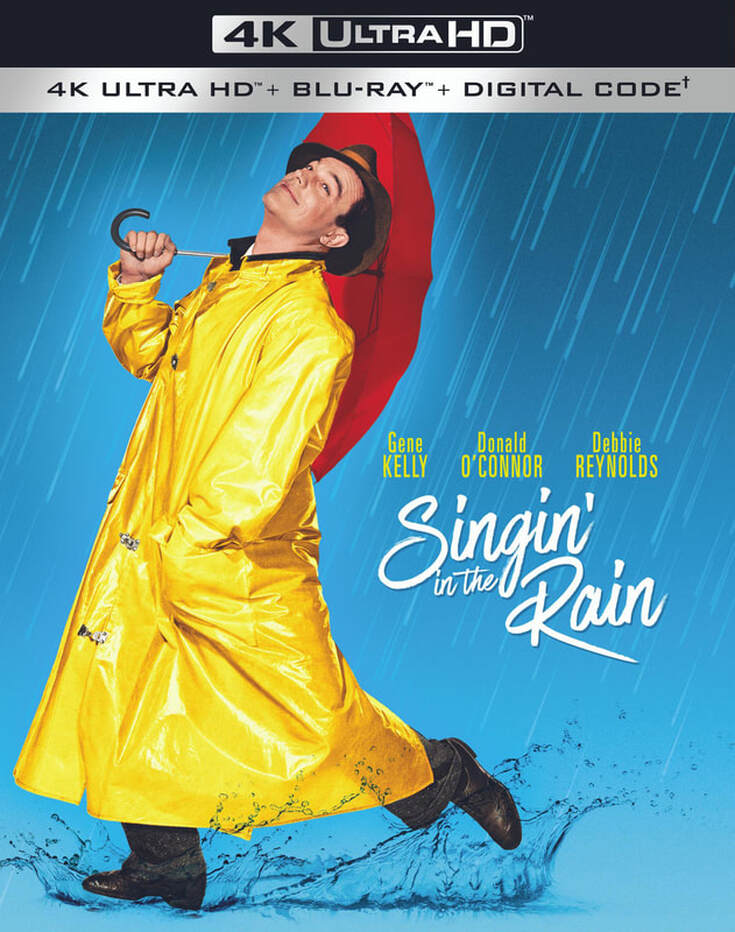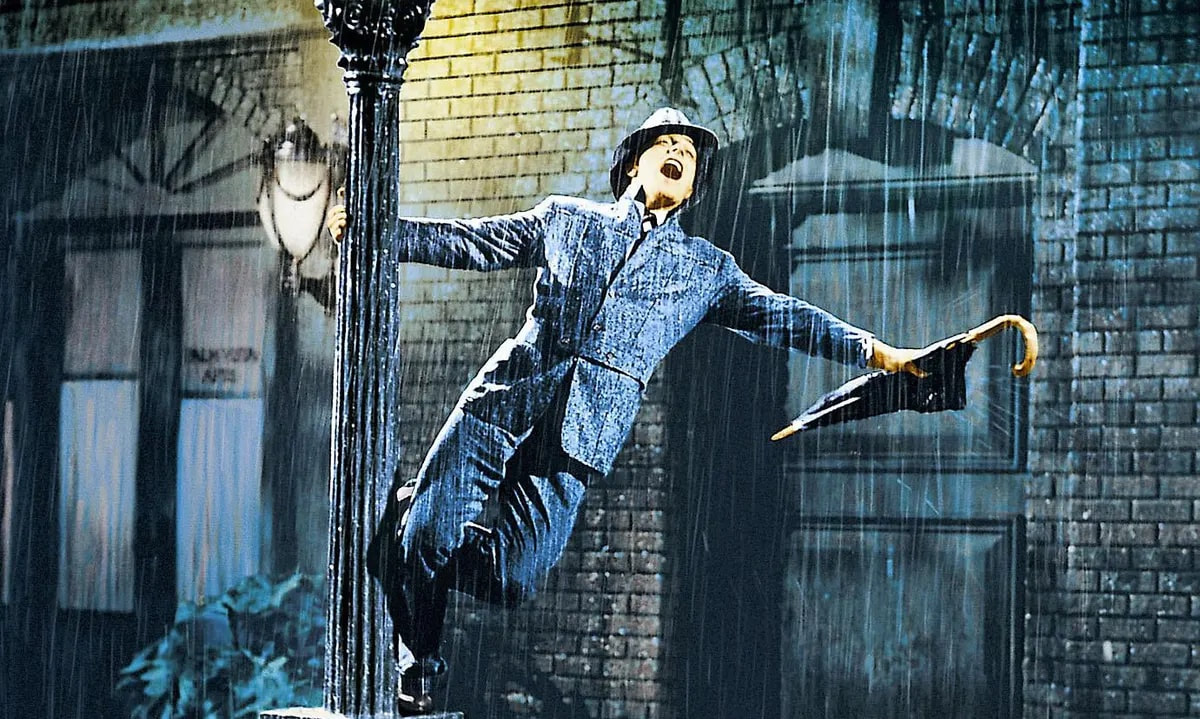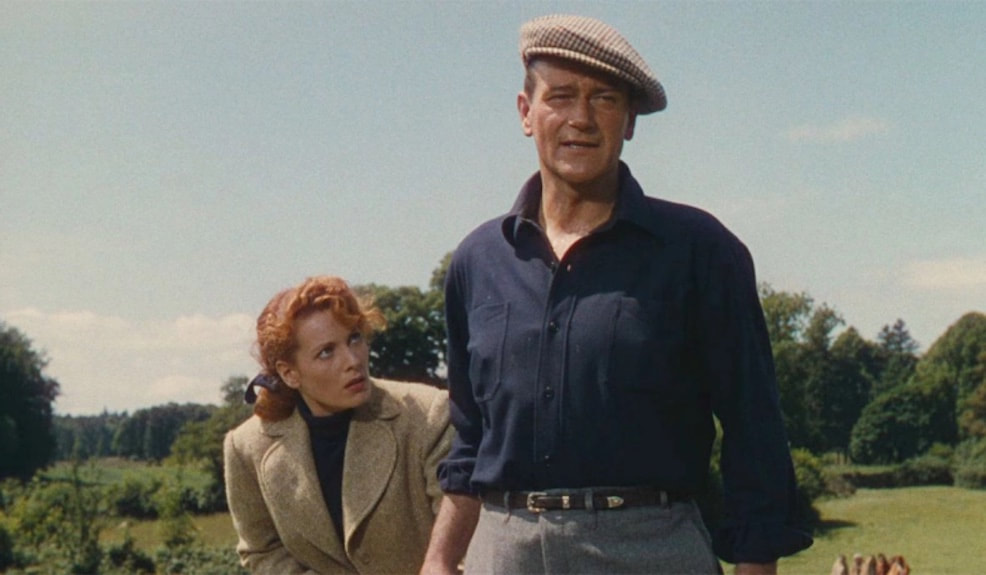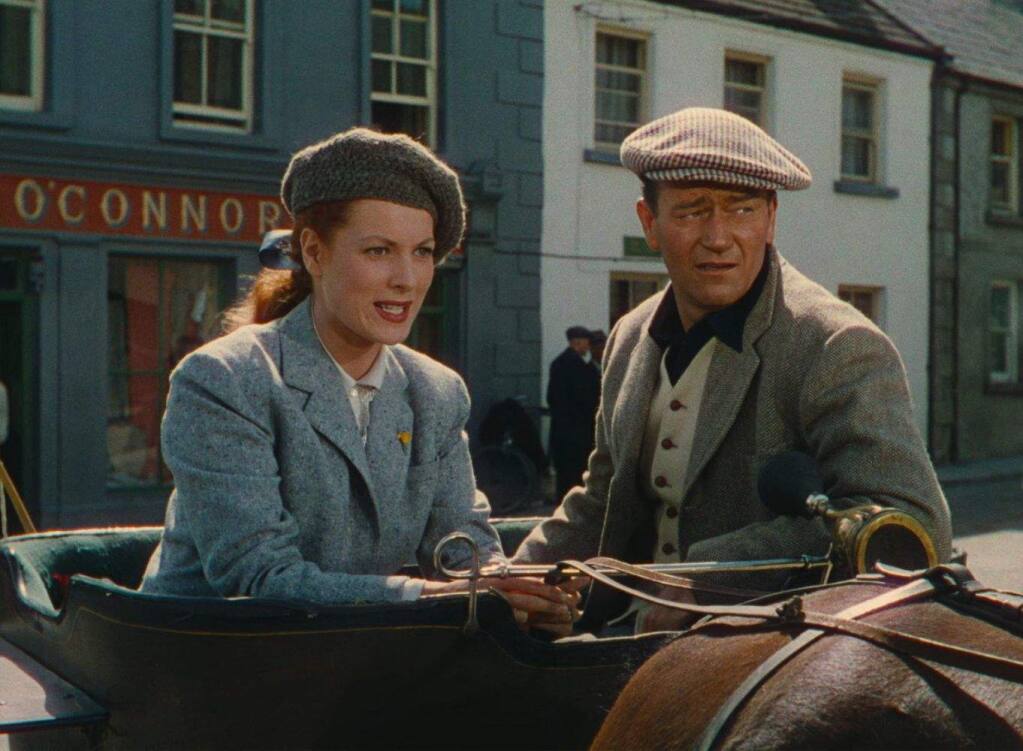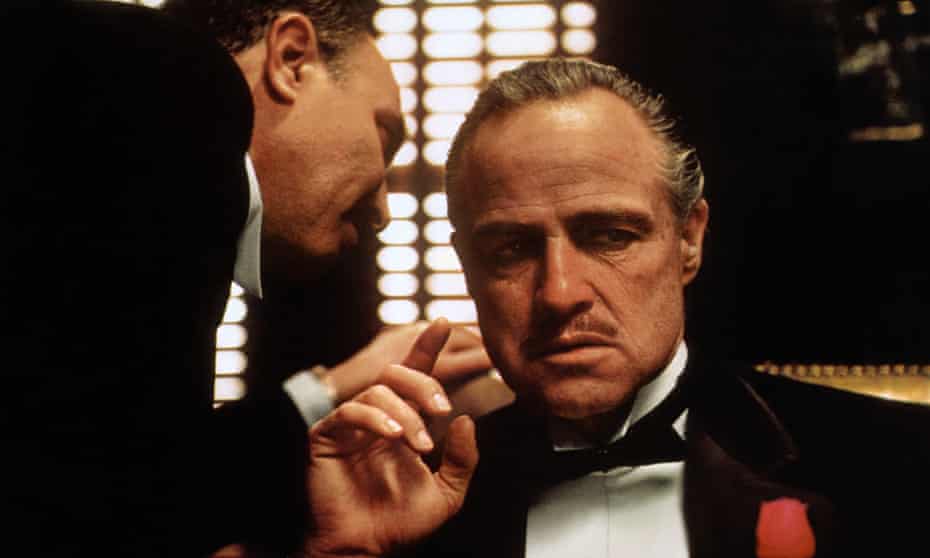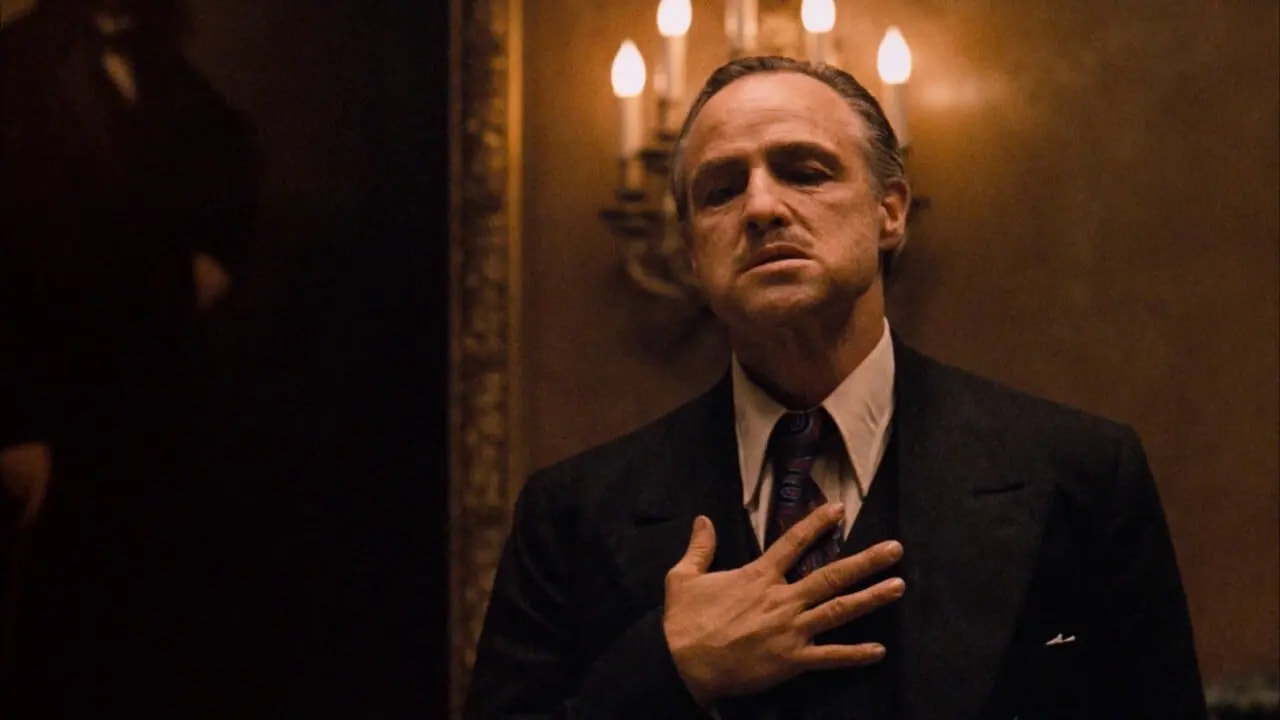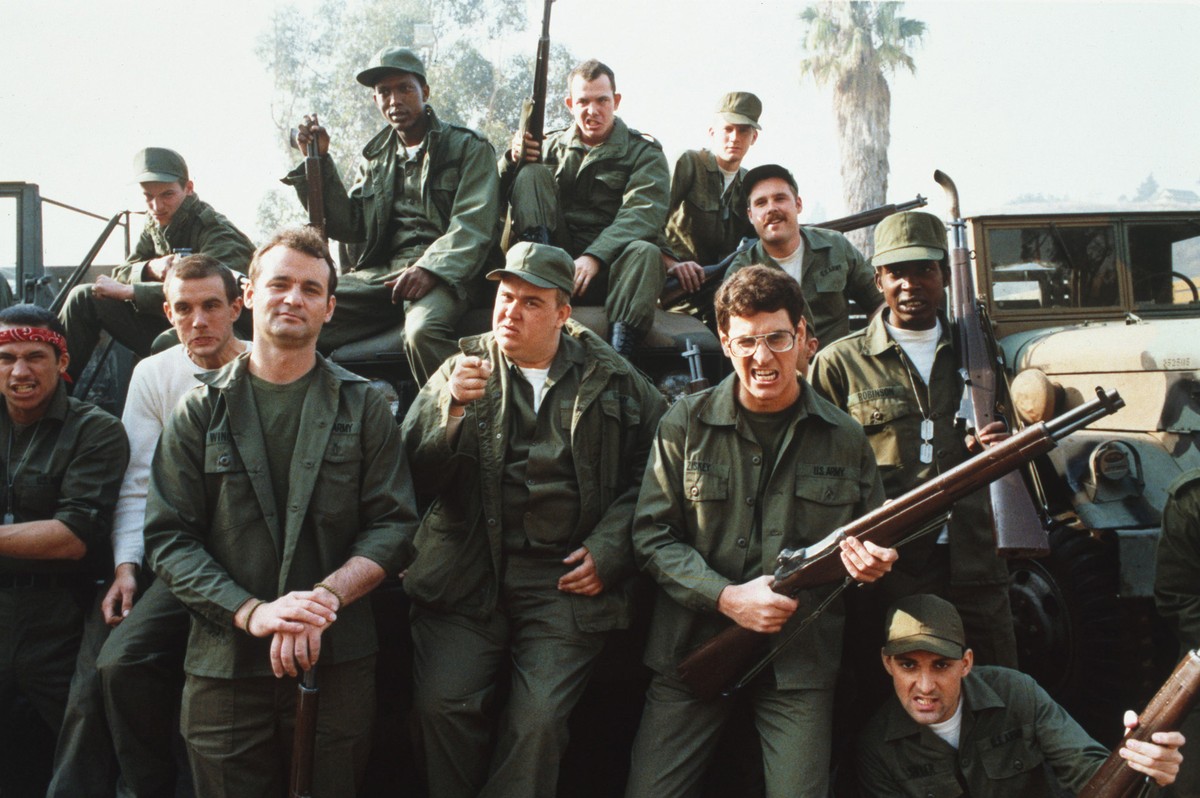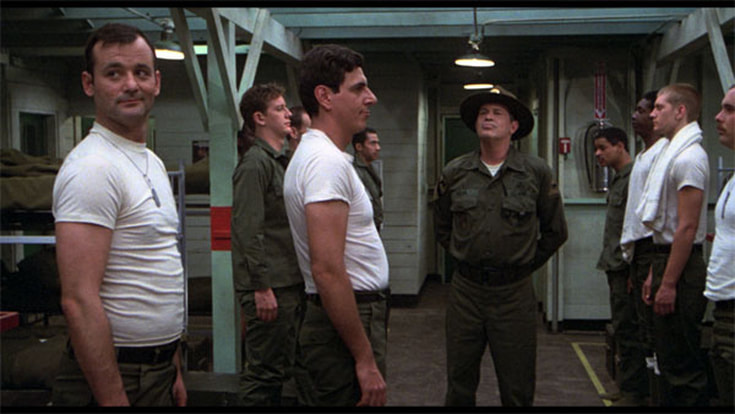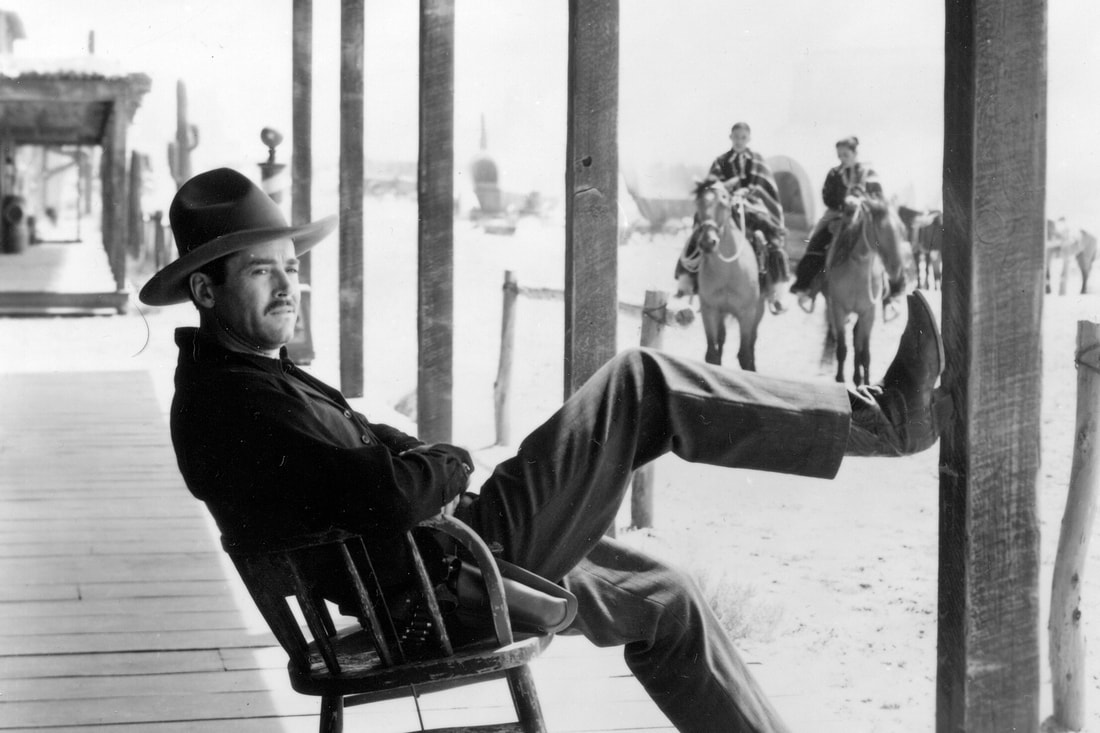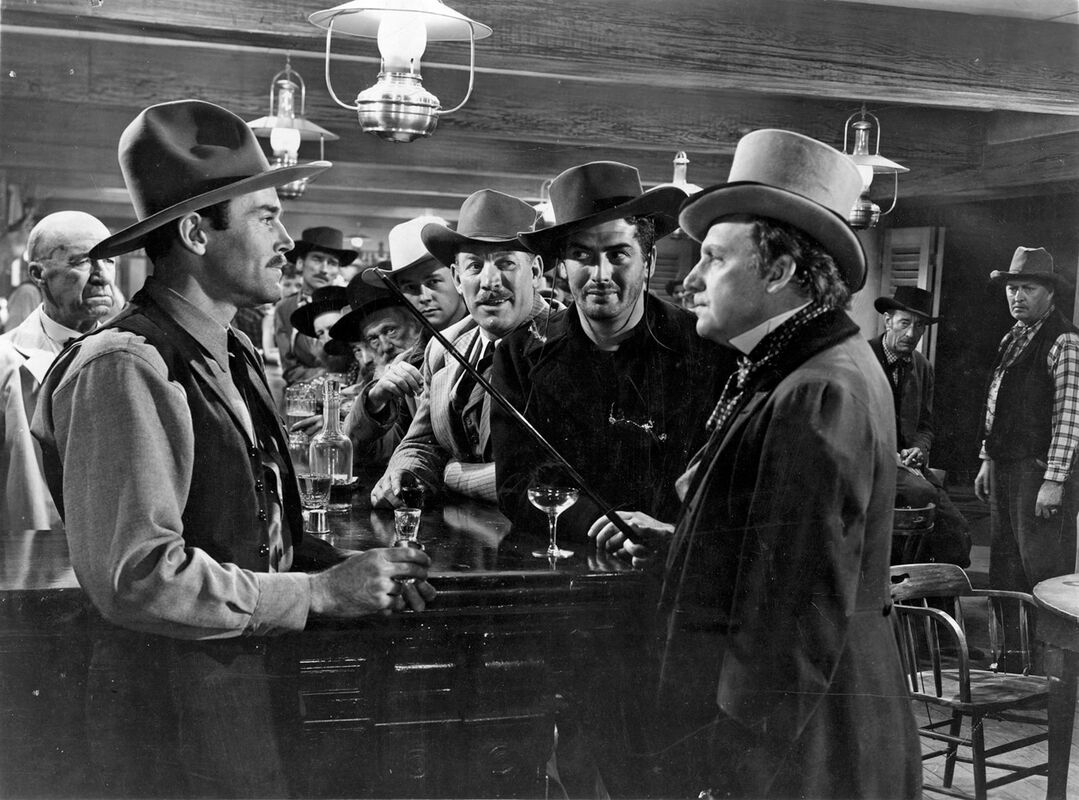|
By Dan Skip Allen Starting in the '40s and going through the '60s was the age of the big Hollywood musical. Sure, musicals trickled on through the rest of the decades, but not like the golden age of musicals. One of the era's biggest stars was Gene Kelly. Arguably his most famous and most important role was as Don Lockwood in Singin' in the Rain. It's a very influential film on many levels, some even considering it the best movie musical of all time. Lockwood (Gene Kelly) and Lamonte (Lina Hagan) are a very popular duo in Hollywood. They bring the crowds in by the droves for their silent pictures. While attending a party, the host shows them and the studio head a talking picture reel. The studio head gets the idea that talkies are the new-fangled thing that will bring the movie industry to the next level. When the picture he is making, The Dueling Cavalier, doesn't sound right, he doesn't know what to do. Singin' in the Rain has a great cast in addition to Kelly and Hagon. Debbie Reynolds, the mother of Carrie Fisher, is Kathy Seldon, an entertainer in her own right. She dances and sings at various parties. When Kelley's character's car breaks down, he gets a ride from her. This is the beginning of an on-again-off-again friendship between the two. Cosmo Brown (Donald O'Connor) is the best friend of Kelly's character. He is always there when he needs a friend to talk to or an idea. They work very well together on screen. Singin' in the Rain is an excellent film for many reasons, and one of them is that it has a great story of the transitioning of silent films into talking pictures. This was a story at the time that depicted something that actually went on in Hollywood a couple of decades before. Some people just couldn't cut it in talking pictures because they didn't have the proper accent or couldn't speak the English language, or have some other talent they needed. Dancing and singing were prerequisites now at this time in Hollywood. It's a big change. Another thing that makes Singin' in the Rain so great is its great musical numbers. "Good Morning," "Make Me Laugh," the title track, "Singin' in the Rain," and so many more vibrant, entertaining songs kept this movie going from beginning to end. The songs are the heartbeat of this wonderful film about change in Hollywood. With Kelly, Reynolds, and O'Connor singing these songs, it was destined to be a success. They are easy to sing along with while watching the film. That's a key to why this was such a success.
Singin' in the Rain also had technical aspects that made it look and sound so good. Technicolor was a relatively new thing at the time that was used to bring this film to life. The various dance numbers are very vibrant. Colorful costumes and sets jumped off the screen. The remastering for the 70th Anniversary didn't hurt the film — it made it better. This film has never looked better than it does now, 70 years later. That's saying a lot for a movie this old to still stand up this far from when it came out originally. Gene Kelly was a massive star when Singin' in the Rain came out. He'd done An American in Paris, Brigadoon, and Hello Dolly, but his biggest and most famous role ever was as Don Lockwood. Kelly danced and sang his way to stardom. He had a charisma and personality that made him a star. Kelly was a talent that has rarely been seen before or since. One of my influences as a film critic is Roger Ebert. His favorite film of all time was Singin' in the Rain. I understand why he loves this film so much. "Singin' in the Rain pulses with life; in a movie about making movies, you can sense the joy they had making this one." This says it all. Once I saw it, I instantly loved it. Seventy years later, it holds up as one of the great musicals and films in general of all time. MGM made a film that will probably influence filmmakers and be enjoyed by film fans like me for decades to come.
0 Comments
By Dan Skip Allen John Wayne (True Grit, The Searchers, Stagecoach) has got this reputation of being a man's man. He is a tough guy if you will, but he played a softer, more compassionate character in his films every once in a while. That is if you consider Sean Thornton a gentler, more compassionate man. After all, he killed a man in the ring as a boxer, which convinced him to leave America and move to a small town in Ireland called Innisfree. Now he's trying to start over fresh. Sean figures he would move back to where his family is from, and he would buy their land and live the rest of his life in peace. Except a man named Will Danaher (Victor McGlagen) is also interested in the land. Sean notices a beautiful redhead named Mary Kate (Maureen O'Hara, How Green Was My Valley, Miracle on 34th Street), who happens to be the sister of Danaher. He tries to get into a relationship with her to spite Danaher, but she's feisty and fiery as redheads tend to be. And what a beautiful relationship it turns out to be. Maureen O'Hara and John Wayne have been in a few other films besides A Quiet Man together: McLintock, Rio Grande, and Big Jake. They have very good screen chemistry from working together on all these films. Some might consider it one of the best on-screen romances ever in Hollywood. I would have to agree with this assessment. These two have a great on-screen dynamic. Another frequent collaborator of John Wayne is John Ford. These two have had a long and prosperous filmmaking relationship with one another. They did quite a few Westerns, making the duo famous in Hollywood. Their films are some of the best movies ever. A Quiet Man might be the oddest film they've done, though. It's not about tough firefighters, WWII pilots, or gunfighters shooting each other and Native Americans. It's a romantic film that hits on all the notes a great romantic film should. With the annual March holiday of St. Patrick's Day coming up, A Quiet Man is a perfect film to revisit. It's one of the greatest films focusing on Ireland. The drama between Wayne and McGlagen's characters is accurate of the time, and the romance is one of the best put to screen. This film also has more to offer than just the story and acting. It has excellent cinematography and music as well.
The cinematography by Winton C. Hoch is gorgeous for the time. The reds and blues are very bright and vibrant, and Ireland's backdrop as a whole is beautiful. The music by Victor Young, mostly bagpipes and horns, is fantastic as well. The film has so much going for it. The story by Ford and others is excellent as well. It's the kind of story many audiences can get behind. As a kid, I was in love with films about Ireland. Darby O'Gill and The Little People and A Quiet Man were my favorites because they romanticized the homeland of my ancestors. The music and drinking were right up my alley. A little too much up my alley. Still to this day, St. Patrick's is my favorite holiday. John Ford, John Wayne, and Maureen O'Hara gave me a film where I could believe in something as a child. My upbringing wasn't perfect, but films like A Quiet Man are something I can go back to time and again and remember what kind of life I wished I could have. A Quiet Man is turning seventy years old this week. If there ever was a film to see at this time of year, it's this one. The beautiful romance, what there is of it, and the redemption story of Wayne's character is all worth watching the film. The music, whether it is an Irish lyric or a slow piano solo and pun intended music to my ear. The look of the film is stunning. The performances by all and direction are fantastic. This film is just a delight no matter how you look at it. What other film would be better suited to watch this St. Patrick's Day holiday than this one? It's one of the best from this trio who have so much familiarity with one another.
By Dan Skip Allen
When I was a kid back about forty-two years ago, I saw The Godfather for the first time. Of course, on television, it was edited down not to show so much blood, and the cursing was cut out. It wasn't till years later that I saw the unedited version in all its glory. That's when I had a full appreciation of the greatness of The Godfather, as well as its sequel. Now it has turned fifty years old, and it still hasn't lost any of the nostalgia it had for me as a kid. As an adult with many years under my belt, I have a new respect for this Francis Ford Coppola classic.
The Godfather is based on the book by Mario Puzo. It chronicles the lives of the Corleone family, of which Don Vito Corleone (Marlon Brando) is the patriarch. He has garnered a lot of respect from his constituents and business associates. Even so, when they need something, they'll come to him at his daughter's (Talia Shire) wedding. He has three sons. One is part of the family business Sonny (James Caan), another Michael (Al Pacino) is just home from the Army, and his third son Fredo (John Cazale) is a little slow, but he's also a part of Genco Olive Oil which is the front for the business. Coppola created a look and feel of the iconic film. Set in the 1940s, the film has a style that sets it apart from any other movie in this genre. It has a grain that makes it have a lived-in feel and a worn-out look. Gordon Willis is the cinematographer, and he leans on a darker paper of colors such as blacks and browns. The inside scenes are perfectly set in these colors. The outdoor scenes show a little more range of tans and peaches that contrast to the indoor scenes. This film looks gorgeous no matter how you look at it. All great films have memorable lines of dialogue that will live in the annals of time. The Godfather is no different. As mentioned before, Don Vito is visited at his daughter's wedding by many to pay tribute, and one of those people is an actor/singer named Johnny Fontane (Al Martino). He comes asking the Don if he can help him land a role in a movie he wants to star in, and Don Vito tells him he'll help him. He asks how and Don Vito says, "I'll make him an offer he can't refuse." Another great quote from the film is when they send their best hitman, Luca Basi (Lenny Montana), to take care of some family business. He doesn't come back. Instead, they get a package delivered, and in it is a fish. They say, "Luca Brasi swims with the fishes." My favorite line in the film is when a hit is made out in the sticks of New Jersey by Clemenza (Richard A Castello) tells his partner, "Leave the gun, take the cannoli." This film is littered with great lines.
This film has a great cast in it. Besides the actors I've mentioned already, there are a lot of teller performances from the supporting cast, such as Robert Duval as Tom Hagan, the consigliere, and Diane Keaton as Kay Adams, Michael's girlfriend and eventual wife. And with all gangster films comes the other family heads and various members of the organization. Abe Vigoda (Tessio), Al Lettieri (Solozzo), and Sterling Hayden (Capt. McCluskey) are all great as the antagonists of the film. This film is filled with Oscar winners and all-time greats. It's one of the best casts ever in any movie.
Besides the cinematography, the film also has some fantastic production design by Dean Tavoularis, makeup and hair design, costumes, and editing by too many to list. The score was by Nino Rota, and it was incredible. It brought you into this world perfectly. This score is iconic for its melancholy, but also its legendary tones. The first few notes are mesmerizing and so memorable to me all these years later. Coppola helped adapt Puzo's book, making this book come to life. The character arks for many of the characters are very satisfying. All the sons of Don Vito have their various plot points, but Michael's arc is one of the greatest in film history. He goes from a mild-mannered son who wants nothing to do with the family business to becoming a cold-blooded killer and the leader of a crime syndicate in the guise of a businessman. In later films, this would become more prominent. The script is a masterpiece by anybody's standards. As years have gone by, I've watched The Godfather probably thirty or forty times. I see something new in it each time I watch it. It has layers that not a lot of films have. It has a rewatchability factor like no other film ever. The family drama, the crime drama, and the character beats are some of the best in any movie. Coppola captured a subsection of society that wasn't that prominent at the time but became an entire genre in later years. Filmmakers like Martin Scorsese made it their own. And various true stories about real-life gangsters were made into films like Goodfellas, directed by Martin Scorsese, Donnie Brasco (which also starred Al Pacino), and American Gangster from Ridley Scott. The Godfather and its sequel have become part of the lexicon of society, not just criminal society like Scarface. Not that awards are important, but they signify greatness, so they must be discussed. The Godfather sits at number 5 on AFI's Top 100 Movies of All Time list currently, and it won three Academy Awards back in 1973 for the '72 calendar year: Best Picture, Best Actor for Marlon Brando (for which he sent Sachin Littlefoot to accept the award on his behalf due to his protest against the treatment of Native Americans in movies and the country), and Best Adapted Screenplay by Coppola and Puzo based on his book. It also stands at number two on IMDb's list of the 250 best movies list. And it won many other awards as well. The fact remains that it's one of the greatest films of all time. It has stood the test of time because of the timeless nature of the story, the incredible characters, and the incredible skill that went into every aspect of the production.
By Dan Skip Allen
Ivan Reitman has had a forty-year career as a director and producer making such movies as Ghostbusters and its sequel, Animal House, Meatballs, Dave, and a few Arnold Schwarzenegger comedies. He has made some iconic films in his career. He has even helped his son become a great director as well. One of his most iconic movies is Stripes, a comedy about two men who join the Army and get more than they bargained for.
John Winger (Bill Murray) is a down-on-his-luck man who lost his job, girlfriend, car, and apartment. He's looking for something to motivate him and get his mind and body right. Russell Disney (Harold Ramis) is his best friend. He teaches migrants how to read and speak the English language. They both need a change in life and a change in mindset. The Army is the right place for them. Along the way, they meet some colorful characters and a couple of enlisted ladies and become friends with them. Along with Murray and Ramos are John Candy as Ox, Judge Reinhold as Elmo, Warren Kate's as Sgt. Hulka, John Larroquette as Capt. Stillman, PJ Soles as Stella, and Sean Young as Louise. This cast is fantastic. It has a lot of standup comedians who improvise quite a bit of the dialogue. The legendary comedians in this film make for many laughs and make for a hilarious ensemble. The military has never been this fun before or ever since. Stripes is full of this ragtag group of individuals who need to come together to help the Army to deploy a new state-of-the-art weapon called an EM-50, basically a glorified motorhome. This ends up being the thing that allows Murray and company to come together. They are not the military type, but they know they need a change — even Sgt. Hulka instigates Murray's character to get him motivated to show what he can do for his country. This is a typical military film. Murray and the cast are great in it.
After all the hijinks that ensue during basic training, the film takes a turn for the better. They have to fight in an encounter, and more laughs and action occur. Reitman knows how to get the audience laughing. Various scenes of mud wrestling and so forth add levity to a film with plenty of laughs already. John Candy shows why he's such a great comedic actor in this scene. This creates great comradery for the group of young soldiers in the film.
As far as military films go, this is one of the better ones. It's no Private Benjamin, but it's pretty good. Both have heart as well as laughs. Reitman knows how to bring the heartfelt moments out while also getting laughs from the audience. This film even has romantic moments between Soles, Murray, Young, and Ramis. The film also has excellent music and nostalgic moments of singing "Do Wah Diddy Dumb Diddy Do" by Manfred Mann while marching and "The Rubberband Man" by The Spinners at the mud wrestling bar. The music by Elmer Bernstein adds another fun element to the film. The military songs are in the movie as well. "Joining the Army" by Nita Leaves is an entertaining song too. Stripes is a fun film that takes the Army and turns it on its head. The superb cast of legendary comedians such as Murray, Ramis, Candy, Larroquette, and others makes a very funny film. Add a little romance and some action, and you have a fun movie. Reitman assembled the right people to bring Len Blum, Dan Goldberg, and Harold Ramis's script to life. All in all, Stripes was the kind of film Murray, Ramis, Candy, and Reitman have been associated with their entire careers. It is a hilarious, nostalgic trip down memory lane for me and I'm sure many others. Reitman will be missed, but he leaves behind a legacy of great work.
By Dan Skip Allen
I would be lying to you if I said I wasn't a big fan of westerns. Unforgiven, High Noon, and Once Upon a Time in the West are among my favorite films of all time. Tombstone is another terrific western, but it was based on My Darling Clementine from 1946, another great film about famous Sheriff Wyatt Earp.
Wyatt Earp (Henry Fonda) is trying to move a herd of cattle through Arizona when he and his brother stopover for a night in Tombstone. When Wyatt wakes up the next morning, he notices that their herd of cattle is gone and one of his brothers is dead. He suspects the Clanton clan, led by Old Man Clanton (Walter Brennan) who live out by the O.K. Corral. Trying to figure out a way to get revenge for his brother, Wyatt becomes the Sheriff of Tombstone. He also befriends an alcoholic gambler known as Doc Holiday (Victor Mature) and the title character of the film, Clementine Carter (Kathy Downs). Fonda's Earp struggles the entire film to try to get his cattle back and apprehend the culprit. The film is based on Wyatt Earp: Frontier Marshal by Stuart N. Lake. It's directed by legendary western director John Ford who worked with John Wayne quite a bit in his career. This film takes a lot from classic western tales, but Wyatt Earp is considered one of the most famous lawmen in history. Henry Fonda plays a great Wyatt Earp and lawman. Later on in his life, he played a very evil villain in the Sergio Leone spaghetti western Once Upon a Time in the West. So he played both sides of the coin in his acting career. He's great as both men, though. It just shows what a great actor Henry Fonda is. His Earp is a very friendly guy. People are generally connected to him because of his friendly demeanor. He doesn't want people to think they can walk all over him, though. That's where his toughness comes in.
Walter Brennan was another very famous actor of the time. He was in quite a few westerns in his career including Rio Bravo, but his most important role was as the Pastor in Sgt. York starring Gary Cooper. Even though he won the Oscars for Supporting Actor in his lifetime. He plays a great villain in My Darling Clementine as Old Man Clanton. A true western villain that resembles others and Stephen Lang channels in Tombstone in 1993.
My Darling Clementine also has great performances from the women, including the title character, in the film from Kathy Downs and Linda Darnell as Chihuahua. They hold their own against great actors like Fonda and Brennan. Their characters are tough and stick up for their own lives in the film as well. A lot of actresses of the time are powerful and can handle themselves in these films with the best actors of the time. These two are very good at that. The film is in black and white, but it looks great and has beautiful cinematography. The music in the film is pretty good as well. The title of the film is sung throughout the film. And it's a very catchy song, but the score is very good as well. The craft departments are all superb in the film. And it's nice to see a film that everything in it is so authentic and makes the film much more watchable than I could have thought. It's a great addition to the Criterion Collection. |
The Snake HoleRetrospectives, opinion pieces, awards commentary, personal essays, and any other type of article that isn't a traditional review or interview. Archives
June 2024
Categories
All
|
|
|
disappointment media
Dedicated to unique and diverse perspectives on cinema! |

